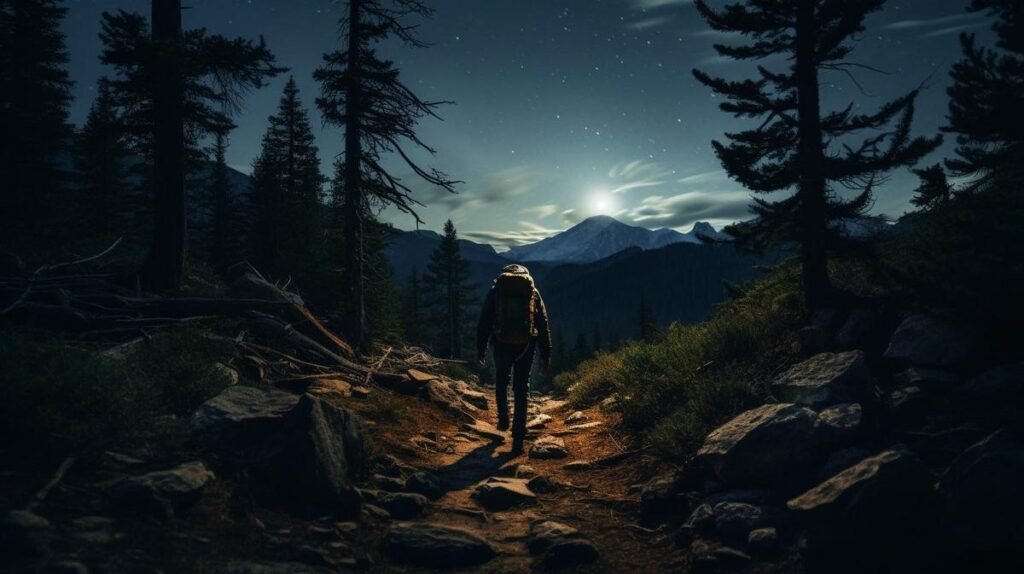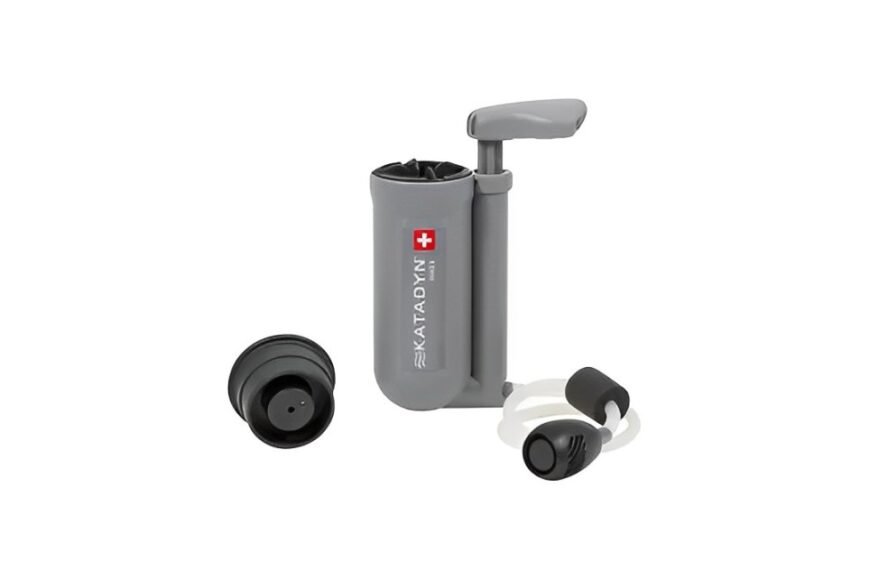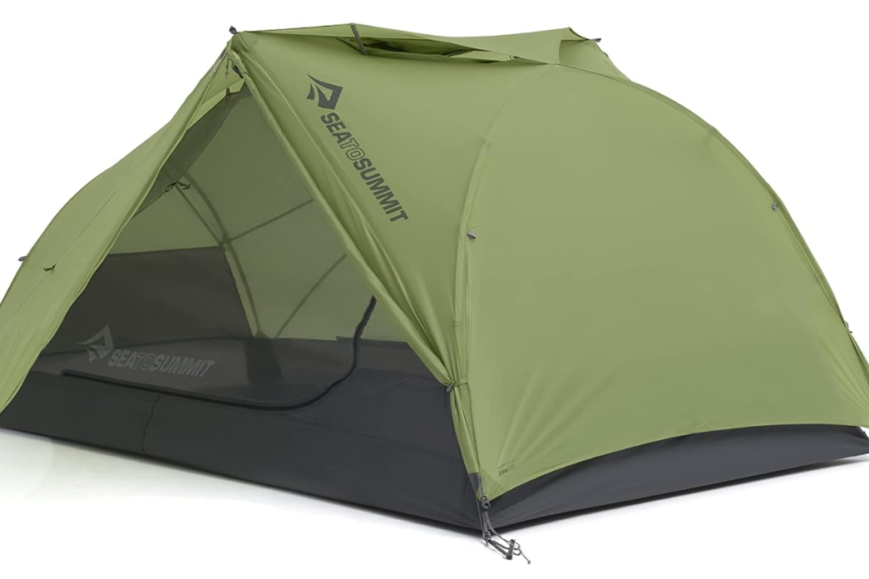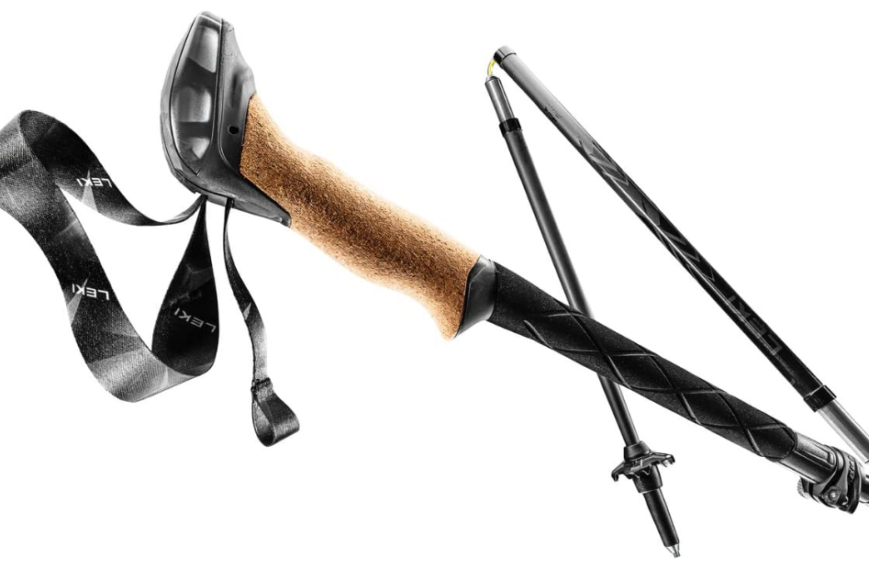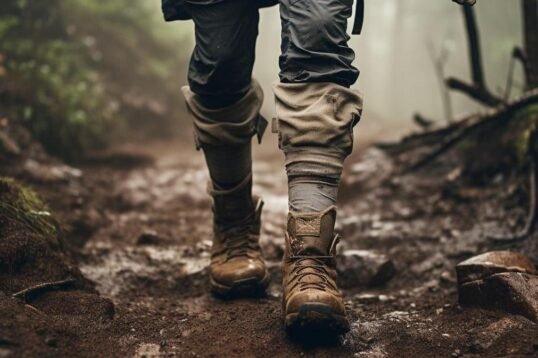- Hiking at night requires preparation: know the trail, alert someone about your plans, carry navigation tools, and prepare for wildlife encounters.
- Pack essential gear such as a headlamp, extra batteries, layered clothing, and navigation tools; make a checklist to not forget anything.
- Nighttime hiking techniques include using night vision aids, maintaining a slow pace, taking frequent breaks, and practicing silent movement.
- For wildlife and stargazing, visit national parks or remote areas; be ethical and don’t disturb animals.
- Use landmarks, and maps, and practice setting up your tent to navigate and camp after dark effectively.
- For packing, list all overnight gear, balance the weight, secure food, and keep essentials within reach.
- Layer your clothing, choose suitable footwear, consider thermal imaging, and use a good headlamp for night hiking.
- Stay hydrated, eat energy-rich foods, and use a red light for cooking without affecting night vision.
- Technology like stargazing apps, reflective trail markers, GPS navigation, and online hiking groups enhance the night hiking experience.
Hey, night owls and trailblazers! Think backpacking at night is a no-go? Think again. Embrace the dark with my key safety tips to keep your night hikes smart and secure. From sniffing out wildlife to shining bright with the right gear, get ready to discover how night-time trekking can be safe and sensational! Let’s light up the trail with knowledge and make your nocturnal adventure unforgettable!
What Are the Essential Safety Tips for Backpacking at Night?
Is hiking at night dangerous? Yes, without the right steps, it can be risky. To keep safe, know the trail, watch for wildlife, and have emergency plans.
Understand the risks the trail may have when it’s dark. Paths can twist, turn, and have things like roots or rocks. Bring a map and compass. Learn how to use them before you go.
Always tell someone where you are going. Use safety alarms and share your location. Bring a fully charged phone. Have an extra battery or power bank too.
Wildlife acts differently at night. Make noise to avoid surprise face-to-face. Carry bear spray if you’re in bear country. Know how to store food so animals don’t get it.
To sleep well while backpacking, pick a safe spot. Set up your tent on flat ground. Stay warm and dry. Use a sleeping pad and bag rated for cold nights.
Remember, safety first, always. Enjoy the stars, but stay aware. Night backpacking can be fun. Just make smart choices and prep right.
How Do I Create a Nighttime Backpacking Checklist?
Night hiking gear—a must-have to stay safe at night. Is it a good idea to hike at night? Yes, with the right equipment.
You’ll need items for seeing and being seen. Start with a strong headlamp or flashlight to light your path. Pack extra batteries or bring a solar charger, as light is your top tool at night. Temperatures can drop, so bring layers to keep warm and dry.
Reflective gear is key for nocturnal treks. Reflective clothing and accessories catch the light, making sure others see you. This increases safety for group hikes and when near roads.
Navigation tools guide your way under the stars. A GPS and map help you track your trail. Always carry backup power to keep your GPS running.
Make a nighttime backpacking checklist with these items. Planning reduces risks and boosts your trek’s fun. This checklist keeps your adventure on track, even after dark. Enjoy the night safely, with every essential in your pack.
What Techniques Can Enhance Nocturnal Hiking Experiences?

Is it safe to trek at night? Yes, with the right gear and knowledge. First, use night vision tools and headlamps well. This gear helps you see and stay on the path. Silent movement matters too. It lets you hear the wild and keeps you safe. Use GPS and old-school maps when it’s too dark. They help you not get lost. Keep your night hiking slow and take breaks often. This keeps you fresh and alert.
Night vision equipment helps trekkers a lot. It lets you see in the dark, away from city lights. Pair this with a strong headlamp and you’re all set. Pick headlamps with a red light mode. Why? It keeps your eyes used to the dark. For silent walking, heavy boots are out. Go light and feel the ground. Your other senses get better, like your hearing. This is a plus out in the woods at night.
Knowing how to use GPS in the dark is key. But don’t rely on just tech. Carry a compass and map, always. And know how to use them. It’s a lifesaver if your gear dies.
For a steady pace at night, walk slower than in the daytime. It lets you deal with the dark better. And, take breaks often, more than the day. Your body and mind will thank you.
To sum it up, with these techniques, you can enjoy a safe nocturnal hike. Gear up, listen to nature, find your way, and keep the pace right. Night hiking can be a magical time. You just have to be ready.
What Should I Know About Wildlife and Star Gazing Destinations?
Are you keen on night hikes? You’ll love the nocturnal wildlife and clear night skies. Recommended destinations for nocturnal wildlife viewing include national parks and reserves. These spots often hold guided night tours to see animals active after dark. For star and moon gazing, seek out remote areas away from city lights. These places are often higher in elevation or dry climates with fewer clouds. Observing bioluminescence phenomena requires specific spots, like coastlines or wetlands. Always be ethical when encountering wildlife; never feed or disturb animals.
When you set out to hike at night, engaging with wildlife takes care but can be magical. In designated parks, some animals only come out when the sun dips. You might see glowing eyes or hear the rustle of nocturnal creatures. For sparkling heavens, you can head to special star-gazing destinations. These are away from the glow of streetlights, offering a canvas of constellations. Dark skies are key for stargazing, so find places known for their clear night views.
Those tiny lights you see on night trails might be bioluminescent critters. They light up to find mates or scare off foes. To see them, you’ll have to visit coastal areas or damp forests after dark. There, you’ll witness nature’s light show.
Remember, keep noise low so as to not scare off wildlife. Do not touch or feed them, as this can harm their health. Stay on trails and use a light red filter to not disturb others. Plus, it’s safer for you and the wild friends you meet on your adventure.
How Can I Ensure Effective Navigation and Camp Setup After Dark?
Finding your campsite in the dark? Look for landmarks shared in descriptions. Use a map and compass or GPS to point you to the right spot. Once there, clear the ground of rocks and sticks to make a flat area.
Need to put up a tent without light? Have a headlamp or hands-free light ready. Work step by step, and know your gear before you leave. This means practice setting up your tent several times in daylight.
Worried about permits or rules? Check the trail’s website or call local rangers before you go. Get any needed permits, and know the do’s and don’ts for when you arrive.
Thinking about staying safe at night? Choose campsites away from walk paths to avoid surprises. Hang food high to keep animals away. Have a whistle or bear spray nearby just in case you need to call for help or shoo a critter.
Let’s dive deeper. When you set off, tell someone your plan and when you’ll check in. This keeps you safe if anything goes wrong. If you’re finding your site and it’s too tough, stay put until first light.
For tents, color-code or label poles and stakes so setup is swift and stress-free. For safety, a circle of light around your site can stop you from tripping in the dark. Also, check the weather. A night of rain can mean a river right where you sleep!
Remember, following these tips can make night backpacking fun, not scary. Stay safe, be prepared, and enjoy the peacefulness of the night outdoors!
What Packing Strategies Should I Consider for Overnight Backpacking?
How do you sleep while backpacking? You need a good packing plan.
First, I make a list of overnight gear. This helps me remember each item. A sleep setup like a tent and a pad is key. A warm bag helps too for cold nights. I pack these first for quick access later.
For evening hikes, balance belongings in the bag. Heavy stuff goes in the middle. This way, the pack feels light on my back. I feel less tired and can walk more.
Food storage is another big deal. At night, critters come out looking for a snack. Keep food in secure containers. Hang them up in a tree if you can. Or use boxes that animals can’t get into.
Each thing I pack has its spot. This is so I can get what I need fast. I use pockets and compartments. This way, when it gets dark, I know where everything is. My headlamp, gloves, and map are close by for easy grabbing.
Valuables like my phone and wallet also need care. I tuck them away safe from both critters and pesky humans. I’m sure to pack my shelter and sleeping kit last. This way, it’s on top for setup at camp.
Essential items I need for a good sleep include a thick mat, a warm sleeping bag, and a cozy pillow. This makes rest in the wild comfortable and restful. Comfort outdoors is all about smart packing and preparedness. With these tips at hand, night trekking and camping can indeed be safe and enjoyable.
What Clothing and Gear Are Best Suited for Night Hiking?
What should I wear for night hiking? Opt for layers. You’ll want clothing that keeps you warm as night temperatures drop. Start with a moisture-wicking base, then add insulation like a fleece jacket, and top it off with a windproof and waterproof shell to protect against the elements.
For your feet, choose the best shoes for night hiking. They should be sturdy, with good grip and ankle support to prevent trips and slips. A proper fit is crucial to avoid blisters which can quickly ruin any night-time adventure.
Is thermal imaging useful for hikers at night? Yes, it can be a game-changer. Thermal imaging lets you see the warmth of objects, making it easier to spot animals or people in the dark. Though it can be pricey, there are affordable options for occasional use.
Finally, a good headlamp is non-negotiable. Your headlamp should be bright enough to light your path, yet not so heavy it strains your neck. Check battery life when choosing one, and consider headlamps with long-running times to avoid being left in the dark. Affordable headlamps are readily available, but make sure they offer sufficient brightness for safe navigation.
Remember, when picking gear for night hiking, balance comfort with safety. It’s not just about staying warm and visible—it’s about being able to respond quickly and efficiently to whatever the night might bring.
What Are the Recommended Hydration and Meal Prep Strategies for Nocturnal Hikes?
Hikers use red lights to keep their night vision sharp. This helps when they make food. You need to drink water often when you hike at night. Even if it’s cool out, your body loses water. So, sip water all through your hike.
Before heading out, eat a meal rich in carbs and protein for lasting power. Think whole grains, nuts, and lean meats. For your hike, pack foods that are easy to eat and full of energy. Foods like trail mix, energy bars, and fruit work well. They give you a quick energy boost without much prep.
You want snacks that blend ease and health. Fresh fruits and veggies, nuts, and seeds are great for a quick pick-me-up. When you want to prep a meal at night, use a headlamp with a red light. This will let you see without hurting your night vision.
Taking the right food and water is key for safe and fun night hikes. Make sure you bring enough to stay strong and hydrated from start to finish. And remember, balance is everything. Choose snacks that give you energy and also taste good. This way, you’ll enjoy every step of your nocturnal adventure!
How Do I Utilize Technology for Better Night Hiking Experiences?
Is it a good idea to hike at night? Yes, if you’re well-prepared. Using technology, you can make night hiking fun and safe. Apps for stargazing help backpackers enjoy the night sky. These apps can show you stars and constellations. It’s like having a map of the sky in your pocket.
You can use reflective or electronic trail markers too. They help you stay on the path and not get lost. Hike planning under moonlight becomes easier. You can see better, and it feels more natural.
Using GPS navigation in the dark is also key. It guides you when you can’t see trails well. Always bring a charged phone or GPS device.
You can even learn from others who hike at night. Online groups like those found on Reddit can give you tips. People share their own stories there. They may know the best spots for a night trek. Or they can warn you about places that are not so safe.
Here’s a quick recap:
- Use stargazing apps to find and enjoy stars.
- Mark trails with things that shine or beep to keep you on track.
- Plan your hike with the moon’s light to make it more natural.
- Share with and learn from online hikers’ groups for good advice.
Don’t forget, that safety always comes first. Happy hiking under the stars!
Conclusion
We’ve covered how to hike safely and smartly at night. Remember, gear upright, from reflective items to headlamps. Plan meals that fuel your trek and keep you going. Know your wildlife and starry skies above. Stick to trails with good markers, and always share your location. Happy night hiking!
![]()

